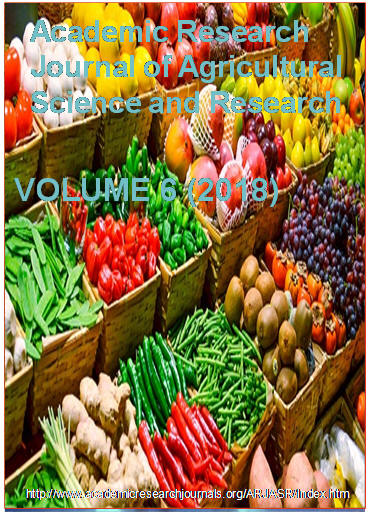| ARJASR |
Academic Research Journal of
Agricultural Science and Research |
||||||||||||||||||||||
|
Academic Research Journal of Agricultural Science and Research Vol. 6(4), pp. 243-250. May, 2018. ISSN: 2360-7874 DOI: 10.14662/ARJASRD2018.019 Full Length Research Review on Sub-Acute Rumen Acidosis in Dairy Cattle and Nutritional Approaches
Demissie Negash
Ethiopian Meat and Dairy Industry Development Institute, P. O. Box 1573 Bishoftu, Ethiopia Tel: +251 912088441, E-mail: demisenegash@gmail.com
Accepted 14 May 2018
Different studies revealed that, Sub-acute ruminal acidosis (SARA) is one of the most important metabolic diseases in modern dairy industry that impairs cow performance and health even well managed and high yielding dairy cows. It is characterized by repeated bouts of depressed rumen pH between 5.2 and 5.6. SARA in dairy cattle causes a disorder of ruminal fermentation caused by the ingestion of large amounts of concentrates and inadequate amounts of fibre administered in order to increase the milk production in early lactation. Furthermore, it has concern of animal welfare reasons due to lameness and laminitis impact significantly on cow comfort and general well-being. Cows in the early lactation, primiparous cows, as well as cows grazing or fed with rapidly fermentable low fibre grass are in particular exposed to high risk to develop SARA. The SARA has diverse and complex consequences, which include feed intake depression, fluctuations in feed intake, reduced diet digestibility, reduced milk yield, reduced milk fat percent, gastrointestinal damage, liver abscesses, and lameness. The suitable approach to prevent SARA is formulating adequate fibre in the diets, preparing diets with adequate particle size distribution and moisture content to reducing sorting. Feeding supplements such as yeast and exogenous buffer can be considered to stabilize rumen pH. The risk of developing SARA can be reduced by adopting a feeding regime, which balances ruminal buffering with the production of volatile fatty acids from fermentation of carbohydrates. Recommendations made for effective characterization, important management factors and good management practices of SARA in dairy cattle are further highlighted.
Key words: dairy cow, sub-acute rumen acidosis, Nutritional impact of SARA
How to cite this article: Negash D (2018). Review on Sub-Acute Rumen Acidosis in Dairy Cattle and Nutritional Approaches. Acad. Res. J. Agri. Sci. Res. 6(4): 243-250
|
|
|||||||||||||||||||||
